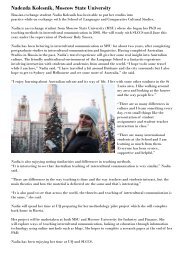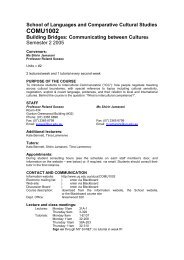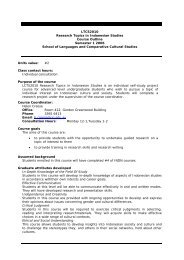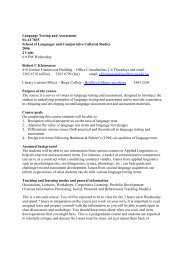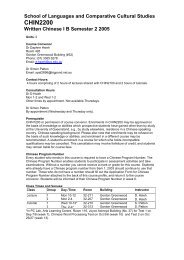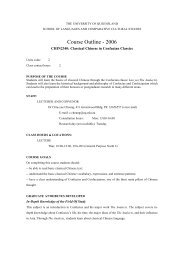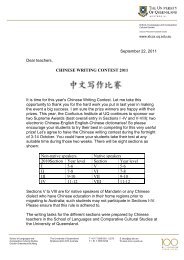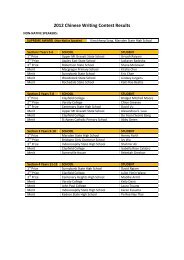JAPN2010 Japanese 1 - School of Languages & Comparative ...
JAPN2010 Japanese 1 - School of Languages & Comparative ...
JAPN2010 Japanese 1 - School of Languages & Comparative ...
You also want an ePaper? Increase the reach of your titles
YUMPU automatically turns print PDFs into web optimized ePapers that Google loves.
<strong>School</strong> <strong>of</strong> <strong>Languages</strong> and <strong>Comparative</strong> Cultural Studies<strong>JAPN2010</strong><strong>Japanese</strong> 1 – Part 2(Semester 2, 2005)Units value: 4 unitsClass contact hours: 6 hoursTeaching staffConvenerEnju NorrisRoom 527Gordon Greenwood Building (#32)Ph.: 3365 6436Email: e.norris@uq.edu.auYuki SayegRoom 531Gordon Greenwood Building (#32)Ph: 3365 6317Email: y.sayeg@uq.edu.auKayoko UchiyamaRoom 522Gordon Greenwood Building (#32)Ph.: 3365 6295Email: k.uchiyama@uq.edu.auAkemi DobsonRoom 439Gordon Greenwood Building (#32)Ph.: 3365 6275Email: akemi.dobson@uq.edu.auAssumed BackgroundEnrolments in <strong>JAPN2010</strong> may be approved on the basis <strong>of</strong> knowledge or abilities which prospectivestudents have gained other than by study <strong>of</strong> JAPN1010 (<strong>Japanese</strong> I – part 1) at The University <strong>of</strong>Queensland, for example, by study elsewhere, residence in Japan, <strong>Japanese</strong>-speaking background.Please also note that enrolments may be refused on the basis <strong>of</strong> such knowledge or abilities, andenrolment in a different course may be recommended. A student's enrolment in <strong>JAPN2010</strong> for whichs/he holds incompatible qualifications may be cancelled. This cancellation may involve forfeiture <strong>of</strong>credit, and students may remain liable for course fees.Course Description<strong>JAPN2010</strong> is the extension <strong>of</strong> elementary level course <strong>of</strong> JAPN1010 (<strong>Japanese</strong> I – Part 1). In thiscourse the students’ basic formal knowledge <strong>of</strong> <strong>Japanese</strong> grammar is further developed so that theycan appropriately and efficiently assimilate the elements and structures essential for functional use <strong>of</strong>the language. Such a strengthened knowledge helps the students develop their skills necessary t<strong>of</strong>urther in-depth knowledge <strong>of</strong> the language.Learning Objectives(1) Effective CommunicationThe main objective <strong>of</strong> this course is effective communication in <strong>Japanese</strong>. Functional aspects <strong>of</strong> thecommunication are learnt through observation and use <strong>of</strong> language samples to which students areexposed. Effective communication is also fostered by engagement in a variety <strong>of</strong> activities whichrequire the use <strong>of</strong> <strong>Japanese</strong> as well by learning appropriateness through observation <strong>of</strong> nativespeaker use <strong>of</strong> it.(2) Independence and CreativityThe students’ independence and creativity are fostered by tasks and activities <strong>of</strong> this course.Through such activities the learners develop the ability to use the language outside the classroom.This ability is crucial to their eventual success in using the language1
(3) Critical JudgmentCritical judgment is fostered through reflection on what it means to learn a language, the nature <strong>of</strong> thelanguage, the social uses <strong>of</strong> language and the relationship between language and culture. Differentvarieties <strong>of</strong> <strong>Japanese</strong> are observed and a critical stance on the status and use <strong>of</strong> these is encouraged.(4) Ethical and Social UnderstandingThe study <strong>of</strong> <strong>Japanese</strong> in this course brings insights into cultural diversity and differences between<strong>Japanese</strong> culture and society and those <strong>of</strong> the students’, developing habits <strong>of</strong> mutual sensitivity andrespect as a basis <strong>of</strong> relationship between individuals and within society.Textbooks Compulsory:• <strong>Japanese</strong> for Everyone. Gakken, Tokyo, 1990• <strong>Japanese</strong> for Everyone Kanji Book Gakken, Tokyo, 1994• <strong>Japanese</strong> for Everyone: Workbook, Gakken, Tokyo, 1994Textbooks Optional:• Sakade, A Guide to Reading and Writing <strong>Japanese</strong>, Tuttle, 1990• Makino and Tsutsui, A Dictionary <strong>of</strong> Basic Grammar, The Japan Times, Tokyo, 1989• Basic <strong>Japanese</strong>-English Dictionary, Bonjinsha-Oxford, 1986.Self-Access and other accompanying materials:• <strong>JAPN2010</strong> Lecture NotesThree copies <strong>of</strong> this are available for loan from the “High-Use” area in the Humanity &Social Science Library. Copies are also available for purchase at POD (Print OnDelivery) in the University Bookshop.• <strong>JAPN2010</strong> DrillsThis booklet will be used in Session 4 (Session S) in the Audio Lab at the Arts LearningCentre (Bldg. 37). In-class copies <strong>of</strong> this booklet will also be provided for your use during thissession.• <strong>JAPN2010</strong> Self-Study materialThree copies <strong>of</strong> this booklet are available for loan from the high use area <strong>of</strong> the Humanity &Social Science Library.• Oral and aural Practice is available online at www.arts.uq.edu.au/alcOnline Language AV material <strong>JAPN2010</strong> Username: student, Password: japn2010.Class StructureThere are six formal class contact hours per week. You are required to attend all six sessions.Session 1 (Session C)• Introduce the week’s objectives, schedules and some <strong>of</strong> the new material.• In-class written tests will be held in this session.Session 2 (Session L)• Reinforcement <strong>of</strong> the new material which have been introduced in Session 1• Introduction <strong>of</strong> some <strong>of</strong> the new material• Introduction <strong>of</strong> new KanjiSession 3 (Session P)• Consolidation <strong>of</strong> the new functions introduced in earlier sessions• Introduction <strong>of</strong> the remaining materialSession 4 (Session S) in the Audio Lab at the Arts Learning Centre• Consolidation <strong>of</strong> patterns and pronunciation practice with audio tapes2
• Listening comprehension activities• Other extended practice using video and audio tapesSession 5 (Session T)• Reinforcement <strong>of</strong> the week’s functions and grammar patterns through reading and writingpractice• Introduction <strong>of</strong> the 2 nd half <strong>of</strong> the new KanjiSession 6 (Session W)• Reinforcement <strong>of</strong> the week’s functions and grammar patterns through speaking activitiesCourse ContentThe course introduces some <strong>of</strong> the functions and associated grammar which will enable you torespond to various situations. The functions include:• making comparisons• stating opinions• recounting past experiences• indicating your intentions• gauging probability• counting years/months/weeks/days• speaking <strong>of</strong> family members• describing giving and receiving• describing changes in state• paying a visit• talking on the telephone• using basic honorific• making speeches introducing yourself to an audience• enumerating facts• speaking conditionally* Note that the <strong>Japanese</strong> taught in this course is the semi-formal style which can be used in mostsituations without being rude. However, when you are actually in contact with <strong>Japanese</strong> people youmay notice that everyday spoken <strong>Japanese</strong> among friends and family members is much moreinformal. It is safer for beginners to use formal <strong>Japanese</strong> until you are able to decide what level <strong>of</strong>speech is required in a particular situation.Pair and group work will be widely used in sessions so that all <strong>of</strong> you are speaking in <strong>Japanese</strong> Theaim is to give you plenty <strong>of</strong> time and opportunity to experiment with new language items and developyour communicative skills, rather than individual students having to wait their turn in a lecturer-frontedclass. The role <strong>of</strong> the lecturer when you are doing pair work is to circulate, answer questions, supplyvocabulary and give advice or modification as needed.Student Preparation and ReviewYou are strongly advised to prepare for each new unit <strong>of</strong> work before the classes in which it is to bepractised. This means familiarising yourself with new vocabulary, revising script from previous weeks,and making sure that you have a good grasp <strong>of</strong> the points already covered in earlier lessons, aslanguage study is cumulative and builds on work already covered. You are expected to spend atleast ten hours studying for this course (five hours for each 2 units) in addition to the six contact hours.It is highly recommended that you do a private study with language drills materials available online(see above “Textbooks” for access) or with tapes at Arts Learning Centre (Bldg. 37) as much aspossible for reinforcement. It is also important to constantly review Kanji which have been introducedin the course. As not all “exercises” in the textbooks will be done during class hours, you areexpected to do the remaining work outside class hours.3
AssessmentTwo Short Tests (15% each) 30% (weeks 6 and 11)The short tests will be held in Session 1 (or Session C) <strong>of</strong> the designated weeks, consisting <strong>of</strong> auraland written questions. It is your responsibility to remember the test dates. If you are unable to takethe test for some reason, contact the convener before the test. If you are sick on the day, a medicalcertificate must be shown and you must come to take the test immediately after you return to theuniversity. The format will be notified during lectures.Two Assignments (5 % each ) 10 % (due weeks 5, and 9)Assignments consist <strong>of</strong> aural and written questions. Answers should be handwritten - DO NOT USE AWORD PROCESSOR. They must be your own work. Although we encourage contact with nativespeakers, enlisting the aid <strong>of</strong> native speakers or advanced students on assignments will beconsidered plagiarism and will be dealt with accordingly (no marks will be given). Assignments shouldbe handed in through the assignment slot at the <strong>of</strong>fice <strong>of</strong> <strong>School</strong> <strong>of</strong> <strong>Languages</strong> and <strong>Comparative</strong>Cultural Studies, level 3, Gordon Greenwood Building (32). Please do not hand assignments directlyto lecturers. Assignments are due at 5 p.m. Thursday <strong>of</strong> the designated weeks. Penalty will be madefor late assignments at the rate <strong>of</strong> 10% per day unless an extension has been sought from theconvener. Assignments will be handed back in class when marked and any which cannot be handedback then will be left in the <strong>School</strong> <strong>of</strong>fice for collection.One Oral Test 15% (week 13)The oral test will be held in Week 13. You will be asked to sign up for their time slot. The format willbe explained during lectures.Final Exam 45%The final examination will consist <strong>of</strong> written assessment items. The format will be explained duringlectures.Assessment for each itemShort Tests:• Ability to understand short aural comprehension passages and provide correct answers toquestions relating to them.• Ability to read and comprehend questions/passages and to provide accurate and appropriateanswers.• Ability to write all three scripts correctly and with the proper shapes, assigning correctreadings to characters in context.• Grammatical accuracy.Assignments:• Ability to read and comprehend questions/passages and to provide accurate and appropriateanswers• Ability to understand short aural comprehension passages and provide correct answers toquestions relating to them.• Ability to write simple passages in <strong>Japanese</strong> where asked• Ability to write all three scripts correctly and with the proper shapes, assigning correctreadings to characters in context.• Grammatical accuracyOral Test• Ability to comprehend questions• Ability to supply appropriate answers• Grammatical accuracy• Pronunciation and fluency• Degree <strong>of</strong> interactivity4
Final Exam• Ability to read and comprehend questions/passages and to provide accurate and appropriateanswers• Ability to write simple passages in <strong>Japanese</strong> where asked• Ability to write all three scripts correctly and with the proper shapes, assigning correctreadings to characters in context.• Grammatical accuracyGrade DescriptorsIt should be recognised that these are generic descriptors only and that in practice people <strong>of</strong>ten varyin strengths and weaknesses across the four skills.GradeDescription7 The student effectively uses communication strategies and is always able tounderstand both written and spoken <strong>Japanese</strong> when vocabulary and structureswhich are introduced in the course are used. The student uses consistentlycomprehensible pronunciation and responds fluently, appropriately andconfidently. In speech and writing the student uses a wide range <strong>of</strong> vocabularyand structures with accuracy and attempts to use language creatively. Scripts andcharacters which have been introduced in the course are used with accuracy.6 The student occasionally uses effective communication strategies andunderstands written and spoken <strong>Japanese</strong> well when vocabulary and structureswhich are introduced in the course are used. The student uses comprehensiblepronunciation and generally responds fluently and appropriately. In speech andwriting the student uses a range <strong>of</strong> vocabulary and structures although accuracy <strong>of</strong>use fluctuates. Creative use <strong>of</strong> language may <strong>of</strong>ten be attempted. Script is usedwith a high degree <strong>of</strong> accuracy.5 The student occasionally uses effective communication strategies andunderstands most written and spoken <strong>Japanese</strong> when vocabulary and structureswhich are introduced in the course are used. The student’s pronunciation isgenerally comprehensible but some lapses occur. Fluency is subject to fluctuation.The student attempts to use a range <strong>of</strong> characters, vocabulary and structures, withoccasional attempts at creativity. While errors occur, they do not on the wholeaffect meaning.4 The student does not use communication strategies effectively. Comprehension <strong>of</strong>written and spoken <strong>Japanese</strong> is generally good but details may be missed ormisunderstood. . The student’s pronunciation is generally comprehensible butsome lapses occur. The student tends to use formulaic expressions rather thanoriginal utterances, and uses a narrow range <strong>of</strong> vocabulary. Script, vocabulary andstructures are mostly used with accuracy; however, errors will occasionally affectmeaning.3 The student never uses communication strategies and demonstrates a limitedunderstanding <strong>of</strong> spoken and written <strong>Japanese</strong>. Pronunciation is frequentlyincomprehensible. The student speaks haltingly, relying heavily on memorisation.There are frequent errors in both speech and writing and in both the form and use<strong>of</strong> scripts.2 The student never uses communication strategies and demonstrates little or nounderstanding <strong>of</strong> written or spoken <strong>Japanese</strong>. Pronunciation is frequentlyincomprehensible and speech is characterised by frequent one-word utterances.Written <strong>Japanese</strong> is extremely limited in range <strong>of</strong> structures and vocabulary, withfrequent errors in form and use <strong>of</strong> scripts1 The student never uses communication strategies and barely attempts tocommunicate at all The student is unable to use most basic scrip nor formsentences in written and spoken <strong>Japanese</strong>. S/he is generally unintelligible.5
At the end <strong>of</strong> semester, grades are awarded on the basis <strong>of</strong> total marks accrued according to thefollowing:Grad Total markse7 85 - 1006 75 - 845 65 - 744 50 - 643 45 - 492 25 - 441 0 - 24Assessment Procedures in the <strong>Japanese</strong> ProgramIt is your responsibility to do this and to know when things are due.If there is a good reason why you cannot hand in an assignment on the due date, you maysee the course convener and request a short extension <strong>of</strong> time. Extensions are granted at theconvener's discretion, and must be requested before the date on which the assignment isdue (not after). Assignments handed in late without prior extension will be docked 10% perday overdue.If you are sick on the day <strong>of</strong> a test, you should contact or leave a message for the convener thatsame day. As soon as you return to the university you should bring a doctor's certificate with you,and arrangements can then be made for you to make up the test. If there is some pressing reasonother than illness which means you cannot do the test on the scheduled day either in your own groupor in any alternative session, you must discuss it with the convener before the day <strong>of</strong> the test.Nobody who comes along after a test day and does not have a doctor's certificate for that day willbe permitted to take the test.If a convener is not in her/his <strong>of</strong>fice at the time you call to make arrangements, you can leave amessage under the door or with the staff in the <strong>School</strong>’s Inquiries Office on the third floor <strong>of</strong> GordonGreenwood Building (tel. 3365 6311, 3365 2270, 3365 2013 or 3365 6314), or you can send her/himemail. Also, most staff have voice mail on their telephones to take messages.Note that the final examination will be held during the examination period. Please do not make travelor other arrangements during this period since special exams will not be granted for any students inthe Faculty for such reasons.Staff Office HoursPlease make a note <strong>of</strong> the consulting hours <strong>of</strong> your teachers and try to see them during thosetimes. They are available for consultation at other times by appointment. Please consult ateacher if you want extra feedback on your work, or if you have concerns about any aspect <strong>of</strong>the course <strong>of</strong> your own work or study.Support for students with a disabilityAny student with a disability who may require alternative academic arrangements in thecourse/program is encouraged to seek advice at the commencement <strong>of</strong> the semester from aDisability Adviser at Student Support Services.6
PlagiarismAll assignments must be your own work. To attempt to pass <strong>of</strong>f as your own work anything that hasbeen copied in part or in full from a book, journal or paper, or any electronic source is plagiarism.Please note that for most language courses, it is also regarded as plagiarism if you submit writtenwork for assessment that has been checked, edited, corrected or written by a native speaker oradvanced student. The University treats issues <strong>of</strong> plagiarism very seriously. To find out more aboutplagiarism find ‘Useits’ under ‘Advice and Training’ on the Cybrary homepage.Timetable ChangeDue to the oral test in Week 13, Session 1 for that week is the only formal class. Sessions 2, 3 and 4are cancelled. Sessions 5 and 6 will be allocated for the oral test. Students are required to turn up atthe time they sign up for the oral test.Weekly ScheduleThe weekly schedule is for your reference when you prepare for each session. If you miss anysessions please also see the following schedule.Week Session 1(Session C)W1July 25 ~JFE L7Part 1W2Aug 1 ~JFE L7Part 2W3Aug 8 ~JFE L8Part 1W4Aug 15 ~JFE L8Part 2W5Aug 22 ~Introductionto the course;review, andbrushing upFIV: orderingevents intime てからFI: modifyingclauseGrammarNote:emphatic use<strong>of</strong> も;FV: listingmore thanone objectや、とか;culture note:publicholidays inJapanFI: describinga change instate (1) になSession 2(Session L)F1: situationcontinuinguntil such atime まで;new Kanjipp.42-43,nos.82-88ReinforceFIV;practice <strong>of</strong>particles;new Kanjipp.48-49,nos.96-102New Kanjipp.54-5,nos.107-14;F II: reasonor explanationusingて-formFVI:comparisonのほうが;New Kanjipp.60-61,nos.123-129FII:describingthe presentSession 3(Session P)FII: telling apast exp. ことがある;FIII: stating aplan orintention つもりFV: indicatingthe degree <strong>of</strong>certainty かもしれない;dialogue I(Lesson 7)F III: doingsomethingwhile doingsomethingelse ながら;review FIFVII: statingan opinionと 思 うGrammarNote: furtheruse <strong>of</strong> の;7Session 4(Session S)Drills pp 1-5;JFE dialogueI & II; video(FIII)Drills pp 6-9,JFE p.105Reading &ListeningComp.; video(FV)Drills pp 10-13, JFE L8Dialogue,video(weatherforecast)Drills pp 14-18, JFEp118,Reading andListeningComp., videoDrills pp. 19-22; video(review FII)Session 5(Session T)New Kanjipp.44-45,nos. 89-95;Reinforce FIIIReinforce FV; new Kanjip.50 nos.103-106;writingpracticeFIV:countingunits <strong>of</strong> time– years,months,weeks, days;new Kanjipp.56-57,nos. 115-122New Kanjipp.62-63,nos.130-136;readingpracticePractice –talking aboutfamily; newSession 6(Session W)Speakingpractice;review andreinforce thisweek’slearningReview <strong>of</strong>Lesson 7;reading andspeakingpractice;Kanji practiceReview;speaking andreadingpracticeSpeakingpractice -talk aboutjobs,conductinterviewsandsummarisethe findingsSpeakingpracticeAssessmentitemsAssignment 1to be handedoutAssignment 1(5%) due5 pm Thurs.Format <strong>of</strong>Test 1 to benotified
JFE L9Part 1W6Aug 29 ~JFE L9Part 2W7Sept 5 ~JFE L10Part 1W8Sept 12 ~JFE L10Part 2W9Sept 19 ~JFE L11Part 1W10Oct 3 ~JFE L11Part 2W11Oct 10 ~るstate usingthe progressform ている; new Kanjipp.66-69,nos.137-150Test 1 FV: givingand receivingあげる、くれる、もらう;GrammarNote 1:transitive &intransitiveverbsFIII:describingthe change <strong>of</strong>state (2) にする、くするFI: so many<strong>of</strong> each; newcounters:部 、 番 目 、 回FIII: adverbialuse <strong>of</strong> てform, review<strong>of</strong> functionsusing て formTest 2new Kanjipp.70-71,nos.151-157GrammarNote 2:“already”もう、まだFI: describingthe presentstate てあるている; newKanji pp.74-5, nos.158-65FIV: <strong>of</strong>feringto dosomething ましょうか;New Kanjipp.76-77,nos.158-165FII: doingsomething asadvancepreparationておく; newKanji pp.80-81, nos.172-178FIII: Listingmore thanone object も~も; FIV:speaking <strong>of</strong>familymembersFV: givingand receivingReview FI;FII: to dothoroughlyandcompletely てしまうFV: paying avisitReview FI;kanji practiceDrills pp 23-25, JFE L9Dialogues I,II & III, JFEp.130-131Reading &ListeningComp.;<strong>Japanese</strong>song (FV)Drills pp.26-29; video ている、てあるDrills pp.30-33; JFE L10Dialoguespp.132-133;JFE Reading& ListeningComprehensionp.143;video payinga visitDrills pp.34-35; JFE L10Dialoguespp.144-145Mid - Semester BreakFIV: action FV: talkingcompleted by on thesuch a time phone;までに; new introductionKanji pp.86- to keigo87,nos.186-192FI: telling FII: personalwhat ought to andDrills pp.36-37, JFE L11Reading andListeningComprehensionp.153;telephonecalls; videoDrills pp.38-40; video:Kanji pp.68-69, nos. 144-150JFE L9Dialogue I,JFE p.130ReadingComp.;<strong>Japanese</strong>songWritingpractice:writinginvitationcard; use げんこうようしReading andlisteningpracticeReview <strong>of</strong>newfunctions;new Kanjipp.82-83,nos.179-185Unseenpassagereading; newKanji pp.88-89, nos.193-199FIII: to be inexcess すぎJFE L9Dialogue II &III; Speakingpractice –visiting andgift giving aTest 1 (15%)(L7 & L8)held atSession 1Japan Trivia Assignment 2to be handedoutSpeakingpractice:paying a visitJFE ReadingComprehensionp.153;SpeakingpracticeSpeaking:telephoneconversationAssignment 2(5%) due5 pm Thurs.Format <strong>of</strong>Test 2 to benotifiedFormat <strong>of</strong>Oral Test tobe notifiedFIV: Test 2 (15%)conditional た (L9 & L10)8
JFE L12Part 1W12Oct 17 ~JFE L12Part 2W13Oct 24 ~ExamPeriodFV:enumeratingfacts し、しReview(handout)be; new Kanjipp.92-93,nos.200-206FVI:adverbial use<strong>of</strong> adjectives;new Kanjipp.98-99,nos.215-212impersonaldecisions ことにする、ことになるFVII:introducingyourself, JFEL12Dialoguespp.164-165reviewDrillspp.41045,JFE L12Dialoguespp.154-155,Reading andListeningComprehensionp.165る; new Kanjipp.94-95,nos.207-214JFE L12ReadingComprehension;readingand writingexercises,new Kanjipracticeら、たらいい held atSession 1Review JFEL7 – L12’practice fororal testFormat <strong>of</strong>final examsto be notifiedNo class No class No class Oral test Oral test Oral Test(15%) atSessions 5 &6Final Exam(45%)L7 – L12Kanji for <strong>JAPN2010</strong>Session 2 Session 5W1L7pp.42-43, nos.82-88区 、 役 、 所 、 外 、 国 、 出 、 入pp.44-45, nos.89-95地 、( 下 )、 鉄 ( 行 ) 駅 、 家 、 朝W2L7pp.48-49, nos.96-102( 話 )、 漢 、 字 、 用 、 品 、 夏 、 花pp.50-51, nos.103-106切 、 銀 、 紙 、 市W3L8pp.54-55, nos.107-114夜 、 遠 、 近 、 度 、 思 、( 生 )、 活 、( 読 )pp.56-57, nos.115-122音 、 楽 、 目 、 足 、( 食 )、( 書 ),( 上 )、 広W4L8pp.60-61, nos.123-129絵 、( 後 )、 部 、 長 、 曜 、 和 、 洋pp.62-63, nos.130-136野 、 横 、 浜 、 谷 、 石 、 次 、 葉W5L9pp.66-67, nos.137-143手 、 魚 、( 言 )、 方 、 住 、 商 、 員pp.68-69, nos.144-150父 、 母 、 兄 、 弟 、 姉 、 妹 、( 私 )W6L9pp.70-71, nos.151-157夫 、 妻 、 主 、( 前 )、 買 、 英 、 去W7L10pp.74-75, nos.158-165茶 、 居 、 堂 、 空 、 新 、( 聞 )、 少 、 作W8L10pp.76-77, nos.166-171門 、 関 、 台 、 室 、 浴 、 階W9L11pp.80-81, nos.172-178産 、 業 、 営 、 課 、 貿 、 易 、 支pp.82-83, nos.179-185名 、 議 、 客 、 具 、 式 、 残 、 屋W10L11pp.86-87, nos.186-192昼 、 番 、 号 、 角 、 西 、 南 、 北pp.88-89, nos.193-199自 、 動 、 店 、 事 、 道 、 島 、 工W11L12pp.92-93, nos.200-206場 、 知 、 報 、 仕 、 早 、 飲 、 帰pp.94-95, nos.207-214両 、 親 、 族 、( 毎 )、 定 、 問 、 題 、 答W12L12pp.98-99, nos.215-2-21元 、 夕 、 文 、 化 、 写 、 真 、 婦Welcome to the course.9


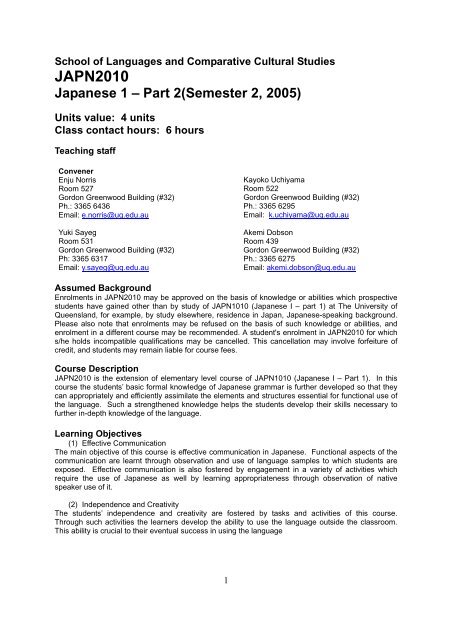
![[first_name] [last_name] - School of Languages & Comparative ...](https://img.yumpu.com/50270271/1/184x260/first-name-last-name-school-of-languages-comparative-.jpg?quality=85)
